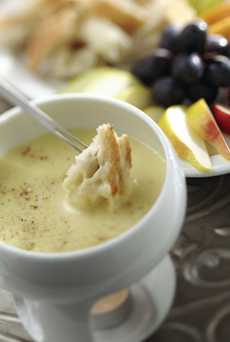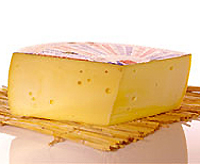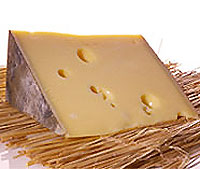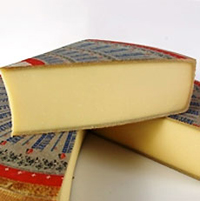
 Classic Gruyère fondue. Photo courtesy Emmi Roth USA. Classic Gruyère fondue. Photo courtesy Emmi Roth USA.
February 2009
Last Updated February 2014
|
 |
Cheese Fondue Recipe
Page 2: More About The Types Of Swiss Cheese
This is Page 2 of a three-page article on cheese fondue—with plenty of recipe choices. Here, the principal types of Swiss cheese. Click on the black links below to visit other pages.
Types Of Swiss Cheese In This Recipe
Each cheese has its own unique recipe. Here’s a brief overview of the differences between the three types of Swiss cheese in the classic fondue recipe on the previous page—one contributing fruitiness, one nuttiness and, depending on age, earthiness. You can read more about the different types of Swiss cheese—there are five categories! And, there are many different ways to create a cheese fondue, with quite a variety of cheeses—as you’ll see on the next page.
- Appenzeller Cheese. Appenzeller is an ancient Alpine cheese, perhaps first made in the 6th century in the Appenzell region in the Swiss canton of St. Gallen. It is a semi-hard cheese made of raw cow’s milk. A thousand
 years ago, Appenzeller was already one of the most popular cheeses in the Alps. It it crafted in 20-pound wheels. During its aging, the wheels are washed with a brine of white wine or cider and spiced with pepper and herbs. This encourages a piquancy that distinguishes Appenzeller from other Swiss cheeses. The cheese develops small eyes and a dense paste, full flavor and a bit more nose and more fruit than a Gruyère. years ago, Appenzeller was already one of the most popular cheeses in the Alps. It it crafted in 20-pound wheels. During its aging, the wheels are washed with a brine of white wine or cider and spiced with pepper and herbs. This encourages a piquancy that distinguishes Appenzeller from other Swiss cheeses. The cheese develops small eyes and a dense paste, full flavor and a bit more nose and more fruit than a Gruyère.
- Emmenthaler Cheese. Emmenthaler, or Emmental, Emmentaler or Emmenthal, is a hard Swiss cheese is known for its large wheels and large eyes (the holes in the
 cheese)—it’s what Americans think of as “Swiss cheese,” but in Switzerland there is no one “Swiss cheese”—every cheese produced in the country is Swiss cheese. It originally comes from the Emme Valley in the canton of Bern. Unfortunately, the name was not protected, so anyone, anywhere can produce a cheese of that name; however, “Emmentaler Switzerland” is AOC-protected, so look for that if you want the real deal. The cheese is aged for at least four months to 14 months. The paste is ivory-colored, mild and slightly nutty-tasting; the longer-aged cheeses develop more complex flavors. cheese)—it’s what Americans think of as “Swiss cheese,” but in Switzerland there is no one “Swiss cheese”—every cheese produced in the country is Swiss cheese. It originally comes from the Emme Valley in the canton of Bern. Unfortunately, the name was not protected, so anyone, anywhere can produce a cheese of that name; however, “Emmentaler Switzerland” is AOC-protected, so look for that if you want the real deal. The cheese is aged for at least four months to 14 months. The paste is ivory-colored, mild and slightly nutty-tasting; the longer-aged cheeses develop more complex flavors.
- Gruyère Cheese. Gruyère is an AOC-protected hard Swiss cheese named after the town
 of Gruyères in the canton of Fribourg. It is made from cow’s milk into giant 80-pound wheels that are aged for 5 to 12 months. Young Gruyère is creamy and nutty; as it ages the paste becomes more dry, earthy and complex. Swiss Gruyère is a solid cheese with no holes. In addition to being an excellent table cheese, Gruyère is an excellent melter, for gratins (and famous toppers for onion soup). Before it gained AOC status as a Swiss cheese in 2001, there were French-style cheeses also labeled as Gruyère (French cheeses such as Beaufort and Comté are very similar in style). Now they cannot be; and French Gruyère-style cheeses must have holes, whereas Swiss Gruyère is a solid cheese with no holes. of Gruyères in the canton of Fribourg. It is made from cow’s milk into giant 80-pound wheels that are aged for 5 to 12 months. Young Gruyère is creamy and nutty; as it ages the paste becomes more dry, earthy and complex. Swiss Gruyère is a solid cheese with no holes. In addition to being an excellent table cheese, Gruyère is an excellent melter, for gratins (and famous toppers for onion soup). Before it gained AOC status as a Swiss cheese in 2001, there were French-style cheeses also labeled as Gruyère (French cheeses such as Beaufort and Comté are very similar in style). Now they cannot be; and French Gruyère-style cheeses must have holes, whereas Swiss Gruyère is a solid cheese with no holes.
Photos courtesy of Murray’s Cheese.
Go To The Article Index Above
Continue To Page 3: 18 Cheese Fondue Recipes
Recipe © Murray’s Cheese. Other material
Lifestyle Direct, Inc. All rights reserved. Images are the copyright of their respective owners. 
|





 years ago, Appenzeller was already one of the most popular cheeses in the Alps. It it crafted in 20-pound wheels. During its aging, the wheels are washed with a brine of white wine or cider and spiced with pepper and herbs. This encourages a piquancy that distinguishes Appenzeller from other Swiss cheeses. The cheese develops small eyes and a dense paste, full flavor and a bit more nose and more fruit than a Gruyère.
years ago, Appenzeller was already one of the most popular cheeses in the Alps. It it crafted in 20-pound wheels. During its aging, the wheels are washed with a brine of white wine or cider and spiced with pepper and herbs. This encourages a piquancy that distinguishes Appenzeller from other Swiss cheeses. The cheese develops small eyes and a dense paste, full flavor and a bit more nose and more fruit than a Gruyère.  cheese)—it’s what Americans think of as “Swiss cheese,” but in Switzerland there is no one “Swiss cheese”—every cheese produced in the country is Swiss cheese. It originally comes from the Emme Valley in the canton of Bern. Unfortunately, the name was not protected, so anyone, anywhere can produce a cheese of that name; however, “Emmentaler Switzerland” is
cheese)—it’s what Americans think of as “Swiss cheese,” but in Switzerland there is no one “Swiss cheese”—every cheese produced in the country is Swiss cheese. It originally comes from the Emme Valley in the canton of Bern. Unfortunately, the name was not protected, so anyone, anywhere can produce a cheese of that name; however, “Emmentaler Switzerland” is  of Gruyères in the canton of Fribourg. It is made from cow’s milk into giant 80-pound wheels that are aged for 5 to 12 months. Young Gruyère is creamy and nutty; as it ages the paste becomes more dry, earthy and complex. Swiss Gruyère is a solid cheese with no holes. In addition to being an excellent table cheese, Gruyère is an excellent melter, for gratins (and famous toppers for onion soup). Before it gained AOC status as a Swiss cheese in 2001, there were French-style cheeses also labeled as Gruyère (French cheeses such as Beaufort and Comté are very similar in style). Now they cannot be; and French Gruyère-style cheeses must have holes, whereas Swiss Gruyère is a solid cheese with no holes.
of Gruyères in the canton of Fribourg. It is made from cow’s milk into giant 80-pound wheels that are aged for 5 to 12 months. Young Gruyère is creamy and nutty; as it ages the paste becomes more dry, earthy and complex. Swiss Gruyère is a solid cheese with no holes. In addition to being an excellent table cheese, Gruyère is an excellent melter, for gratins (and famous toppers for onion soup). Before it gained AOC status as a Swiss cheese in 2001, there were French-style cheeses also labeled as Gruyère (French cheeses such as Beaufort and Comté are very similar in style). Now they cannot be; and French Gruyère-style cheeses must have holes, whereas Swiss Gruyère is a solid cheese with no holes.